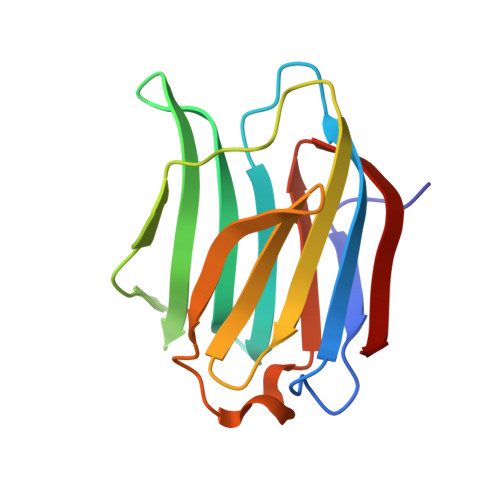The Carbohydrate-Binding Site in Galectin-3 is Pre-Organized to Recognize a Sugar-Like Framework of Oxygens: Ultra-High Resolution Structures and Water Dynamics.
Saraboji, K., Hakansson, M., Genheden, S., Diehl, C., Qvist, J., Weininger, U., Nilsson, U.J., Leffler, H., Ryde, U., Akke, M., Logan, D.T.(2012) Biochemistry 51: 296
- PubMed: 22111949
- DOI: https://doi.org/10.1021/bi201459p
- Primary Citation of Related Structures:
3ZSJ, 3ZSK, 3ZSL, 3ZSM - PubMed Abstract:
The recognition of carbohydrates by proteins is a fundamental aspect of communication within and between living cells. Understanding the molecular basis of carbohydrate-protein interactions is a prerequisite for the rational design of synthetic ligands. Here we report the high- to ultra-high-resolution crystal structures of the carbohydrate recognition domain of galectin-3 (Gal3C) in the ligand-free state (1.08 Å at 100 K, 1.25 Å at 298 K) and in complex with lactose (0.86 Å) or glycerol (0.9 Å). These structures reveal striking similarities in the positions of water and carbohydrate oxygen atoms in all three states, indicating that the binding site of Gal3C is preorganized to coordinate oxygen atoms in an arrangement that is nearly optimal for the recognition of β-galactosides. Deuterium nuclear magnetic resonance (NMR) relaxation dispersion experiments and molecular dynamics simulations demonstrate that all water molecules in the lactose-binding site exchange with bulk water on a time scale of nanoseconds or shorter. Nevertheless, molecular dynamics simulations identify transient water binding at sites that agree well with those observed by crystallography, indicating that the energy landscape of the binding site is maintained in solution. All heavy atoms of glycerol are positioned like the corresponding atoms of lactose in the Gal3C complexes. However, binding of glycerol to Gal3C is insignificant in solution at room temperature, as monitored by NMR spectroscopy or isothermal titration calorimetry under conditions where lactose binding is readily detected. These observations make a case for protein cryo-crystallography as a valuable screening method in fragment-based drug discovery and further suggest that identification of water sites might inform inhibitor design.
Organizational Affiliation:
Department of Biochemistry and Structural Biology, Center for Molecular Protein Science, Box 124, Lund University, SE-221 00 Lund, Sweden.
















